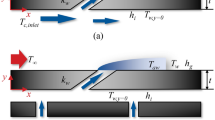Abstract
This article discusses the development of the numerical methods of gas flow coupled with heat transfer, and introduces the fluid net-works method for rapid prediction of the performance of the composite cooling structures in turbine blade. The reliability of these methods is verified by comparing experimental data. For a HPT rotor blade, a rapid prediction on the internal cooling structures is first made by using the fluid network analysis, then an assessment of aerodynamic and heat transfer characteristics is conducted. Based on the network analysis results, three ways to improve the design of the cooling structures are tested, i.e., adjusting the cooling gas flow mass ratios for different inner cooling cavities, reducing the flow resistances of the channel turning structures, and improving the local internal cooling structure geometries with high temperature distribution. Through the verification of full three-dimensional gas/solid/coolant conjugate heat transfer calculation, we conclude that the modified design can make the overall temperature distribution more even by significantly reducing the highest temperature of the blade surface, and reasonably matching the parameters of different coolant inlets. The results show that the proposed calculation methods can remarkably reduce the design cycle of complex turbine blade cooling structure.
Similar content being viewed by others
References
Bunker R S. Axial turbine tips: Function, design and durability. J Propul Power, 2006, 22: 271–285
Han J C, Dutta S, Ekkad S. Gas Turbine Heat Transfer and Coo1ing Technology. London: Taylor & Frallcis, 2000
Tetlow M R, Evans M E. Monte Carlo analysis for a booster fly back guidance system. AIAA Paper 2005-819, 2005
Athavale M M, Ho Y H. Analysis of coupled seals, secondary and power stream flow fields in aircraft and aerospace turbomachines. NASA/CR Paper 2005-212716, 2005
Gamble E J, Gutierrez J. Development of a scramjet/ramjet heat exchanger analysis tool (SRHEATTM). AIAA Paper 2008-4614, 2008
Gamble E J, Giel D. Systematic optimization approach for scramjet/ ramjet heat exchanger analysis tool (SRHE-ATTM). AIAA Paper 2008-5173, 2008
Eifel M, Caspary V, Honen H, et al. Analysis of internal cooling geometry variations in gas turbine blades. J Therm Sci, 2009, 18: 289–293
Lau S C. Enhanced Internal Cooling of Gas Turbine Airfoils, Heat Transfer in Gas Turbines. Sundén B, Faghri M, eds. Southampton: WIT Press, 2001. 109–173
Yang H, Acharya S, Ekkad S V. Numerical simulation of flow and heat transfer past a turbine blade with a squealer-tip. ASME Paper GT-2002-30193, 2002
Kodd B L. Gas turbine technology evolution: A designer’s perspective. AIAA Paper 2003-2722, 2003
Thomas J M, Geoge S D. Analysis and multidisciplinary optimization of internal coolant networks in turbine blades. J Propul Power, 2002, 18: 896–906
Lee D Y, Vafai K. Comparative analysis of jet impingement and microchannel cooling for high heat flux applications. Int J Heat Mass Transfer, 1999, 42: 1555–1568
Baldauf S, Scheurlen M. Correlation of film-cooling effectiveness from thermographic measurements at enginelike conditions. J Turbomach, 2002, 124: 686–698
Hwang J J, Lui C C. Measurement of endwall heat transfer and pressure drop in a pin-fin wedge duct. Int J Heat Mass Transfer, 2002, 45: 877–889
Zeng J, Qing X J. External heat transfer predictions of turbine cascades. J Aerosp Power, 2008, 23: 1198–1203
Hou S P, Tao Z, Han S J, et al. Simulation approach to the fluid-thermal network and the applicaion. J Aerosp Power, 2010, 25: 509–514
Wang S, Wang X J, Yu M Z. Calculations and analysis of a gas turbine air cooling system. Gas Turbine Technol, 2010, 23: 33–37
Guo W, Ji H H, Cai Y, et al. Optimized design approach for internal cooling structure in turbine blades. J Nanjing Univ Aeronautics Astronautics, 2006, 38: 408–412
Wang Q, Guo Z Y, Zhou C, et al. Coupled heat transfer simulation of a high-pressure turbine nozzle guide vane. Chin J Aeronaut, 2009, 22: 230–236
Martin T J. Analysis and multidisciplinary optimization of internal coolant networks in turbine blades. J Propul Power, 2002, 18: 896–906
Martin T J. Computer-automated multi-disciplinary analysis and design optimization of internally cooled turbine blades. Dissertation of Doctoral Degree. Pennsylvania: Pennsylvania State University, 2001
Liu M L. Research on conjugate heat transfer simulation of gas turbine cooling structure with pipe-net method. Dissertation of Masteral Degree. Harbin: Harbin Institute of Technology, 2002. 8–17
Wang H G. Manual for Aerospace Engine Design (Volume 16)-Analysis of Air System and Heat Transfer. Beijing: Aviation Industry Press, 2001. 76–207
Han J C, Park J S. Developing heat transfer in rectangular channels with rib turbulators. Int. J Heat Mass Transfer, 1988, 21: 285–362
Mochizuki S, Takamura J, Yang W J. Heat transfer in serpentine flow passages with rotation. J Turbomach, 1994, 116: 133–140
Florschuetz L W, Truman C R, Metzger D E. Streamwise flow and heat transfer distributions for jet array impingement with crossflow. J Heat transfer, 1981, 103: 337–342
Hylton L D, Milhec M S, Turner E R, et al. Analytical and experimental evaluation of the heat transfer distribution over the surface of turbine vanes. NASA-CR-168015, 1983
Crawford M E, Kays W M. A program for numerical computation of two-dimensional internal/external boundary layer flow. NASA-CR-2742, 1978
Author information
Authors and Affiliations
Corresponding author
Rights and permissions
About this article
Cite this article
Yan, P., Shi, L., Wang, X. et al. Retrofit design of composite cooling structure of a turbine blade by fluid networks and conjugate heat transfer methods. Sci. China Technol. Sci. 56, 3104–3114 (2013). https://doi.org/10.1007/s11431-013-5394-z
Received:
Accepted:
Published:
Issue Date:
DOI: https://doi.org/10.1007/s11431-013-5394-z




